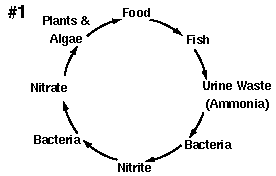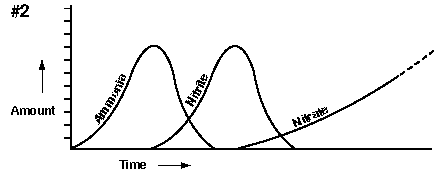
Dan Miller
Camarillo, California
This month's topic is water quality. Water quality is one of the most important aspects of our hobby and usually one of the least understood. Good water quality is not only mandatory for the well-being of our fish but also for our enjoyment of our ponds. It's pretty hard to enjoy a smelly pond full of dying fish.
The basic concept to understand is the nitrogen cycle. The cycle begins when fish eat and then excrete ammonia. The ammonia is toxic to fish and must be removed or changed to a harmless form. Bacteria in the biological filters eat the ammonia and excrete nitrite. Nitrite is also toxic to fish and needs to be removed or changed. Another type of bacteria in the filters eats nitrite and excretes nitrate. Nitrate is non-toxic to fish in small quantities and is used by plants as fertilizer. Completing the cycle, the fish eat the plants and again excrete ammonia.
In koi ponds the cycle is interrupted because we have too many fish and not enough plants for natural biological cycling to occur. This is the reason we must do regular partial water changes to remove nitrates along with other dissolved pollutants. Think of nitrate as smog: a little is unnoticeable, a medium amount is uncomfortable, and a lot is unhealthy. Additionally, long term exposure to a medium amount is unhealthy.
In the following two diagrams #1 is a simplified nitrogen cycle

and #2 is a graph of typical ammonia, nitrite, and nitrate cycles in our ponds.

What you can do to maintain proper water quality in your pond:
1. Have adequate filtration for your pond size and number of fish. Sufficient filtration includes:
2. Don't overcrowd the pond with fish. This stresses the fish and generates too much waste matter for the filter to handle.
3. Do regular water tests for ammonia and nitrates. An increase in ammonia in an established pond indicates it's time to clean the filter. An increase in nitrates indicates it's time to do a partial water change.
4) Do regular partial water changes; 20% every two weeks to one month and daily flushing of the settling tank would be ideal. This removes a portion of the water and reduces the nitrate level.
In summary, a basic comprehension of the nitrogen cycle is necessary to understand the function of the filter. The regular testing of water is necessary to monitor the correct operation of the filter, and regular water changes are essential to maintain a healthy environment in even the best designed and filtered systems.
Return to Koi Ponds and Filters
Copyright © 1996, Dan Miller, Revised May 10, 1996